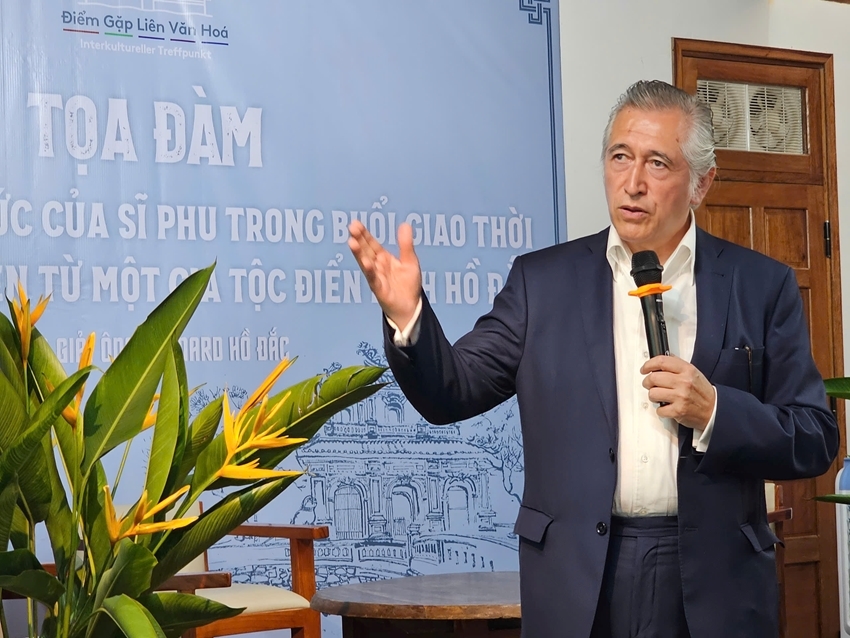The story unfolded nearly 100 years ago and was recounted by Bernard Ho Dac, son of Ho Dac Cung, during the seminar “The Intelligence and Virtue of Scholars in the Transitional Period at the End of the Nguyen Dynasty: A Case Study of the Ho Dac Family,” held on the morning of April 24.
 |
| Mr. Bernard Ho Dac shared the story of his father at the seminar |
The seminar took place at the Intercultural Meeting Point - Lan Vien Co Tich (Bach Dang Street, Phu Xuan District) and attracted a large number of researchers and culture enthusiasts.
In detailing the life of his father, Ho Dac Cung, Bernard Ho Dac - who is of both French and Vietnamese descent-spoke not only with emotion but also with pride. In turn, the audience was equally astonished by the historical figure’s extraordinary journey of "entrepreneurship.”
Born in 1907 in Hue, Ho Dac Cung began his education at Nguyen Phan Long School in old Saigon. He later pursued studies in France at the École d'Électricité Industrielle in Montpellier. After graduating, he worked there for two years before returning to Saigon.
In Saigon, Mr. Cung worked as an auto mechanic. In his spare time, he was passionate about studying airplanes. One day, after seeing a small aircraft known as a “sky louse”, he decided to model a new version himself. However, when completed, the "sky flea" was unable to fly due to missing wheels and an engine.
Back then, he had ordered those items from the Poinssard Company in France. However, due to the enormous cost, Mr. Cung boldly wrote to Emperor Bao Dai, requesting financial assistance.
As reported in Trang An Newspaper issue No. 25 (dated May 24, 1935): "After sending the letter, Mr. Ho Dac Cung had the sense that it would be crumpled and thrown into the trash. But recently, he received news that the Dong Phap Bank in Saigon wanted to meet with him." To his surprise, he went there immediately and was handed a small note with a few simple lines informing him that his letter to the Emperor had been noticed: "By the order of His Majesty Emperor Bao Dai, mechanic Ho Dac Cung is granted a sum of 300 piastres." Overjoyed, after receiving the substantial amount, Mr. Ho Dac Cung immediately sent a request to France urging them to ship the machinery as quickly as possible. Once the machinery arrived, he would fly to Hue to personally thank His Majesty the Emperor.
Subsequently, Trang An Newspaper issue No. 75 (published on November 15, 1935) reported: "News from Saigon stated that Mr. Ho Dac Cung's small plane, called the 'sky louse', was recently flown by him at Tan Son Nhat Airport on a midday flight. The plane soared high, rising and descending as desired. After several repairs, the plane was finally operational. During the first test flight, Mr. Cung tried it at Tan Son Nhat Airport, but despite the propeller spinning, the plane couldn't take off due to a loose wing attachment. On the second attempt, on October 26, the plane took off but suddenly nosedived at a high altitude, putting Mr. Cung in great danger. The third attempt was successful, and the plane flew smoothly. It seemed he was preparing to fly to Hue."
 |
| Story of Mr. Ho Dac Cung, recounted by his son Bernard, took many by surprise |
Bernard Ho Dac recounted that after the accident, his father traveled to France and founded a technical company. He later went on to work in Tunisia. Before his death in 1984, Mr. Ho Dac Cung shared with his son stories of his homeland, his ancestors, and his ambitions.
Inspired in part by his father, Bernard Ho Dac achieved early success. At just 22 years old, he founded CRIFA, a Franco-German Research and Development Agency specializing in modern civil engineering technologies.
He later joined SICOM, where he became CEO and developed the use of fiberglass tension technology, integrating the first fiber-optic-based monitoring system. He pioneered the method for continuous structural monitoring using optical cables, supporting the approach favored by structural engineers. SICOM would later evolve into OSMOS, where Bernard Ho Dac served as Founding Chairman and CEO.
In 1993, Bernard Ho Dac was entrusted with the supervision of the Eiffel Tower, a landmark that has endured to this day. As an inventor, he held over 35 patents and authored numerous publications on inter-company cooperation, prestressing, and structural monitoring.